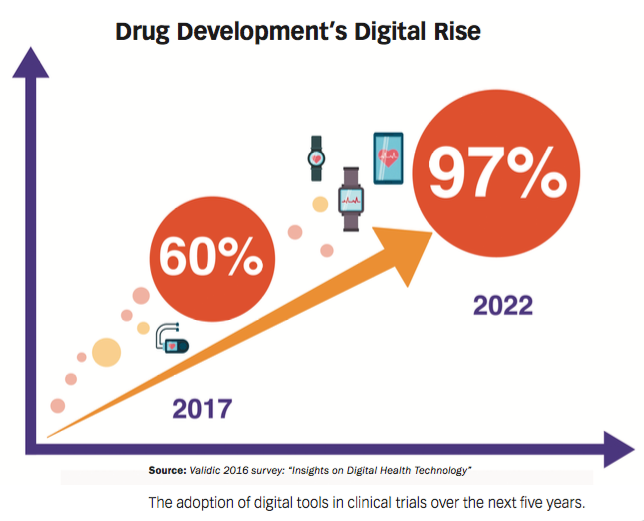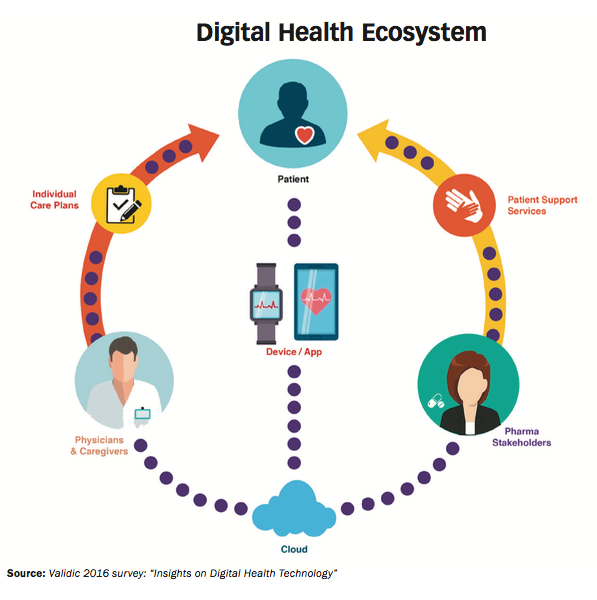Building a Digital Health Infrastructure
Pharmaceutical Executive
Outlining the four core elements pharma companies need to lay the foundation for a solid digital health infrastructure.
The Core Four Elements of a Solid Digital Health Infrastructure: Digital health devices, and the data and insights that they provide, are changing the way the pharma industry engages with patients and providers. Here’s how-and what-companies can do to lay the groundwork for success.
Digital devices and applications deliver on patients’ desire to take control of their health by being more informed and empowered, enabling a more personalized and supportive healthcare experience. On the healthcare provider’s end, real-time health data tracking and monitoring allow providers to keep up with patients outside of regular doctor visits, alerting them to problems that require immediate attention-a more efficient way of providing care.
The opportunities that digital health data offer pharmaceutical companies are just as significant. Data from digital health devices can help teams understand which patients will get the most value out of specific programs, allowing for more easily personalized services. For example, based on segmented patient data, companies can design a patient services program to provide unique support to patients with comorbid diseases, or can adjust their program to suit the needs of patients receiving private, in-home care. Digital health data also can lead to vast improvements in clinical trials-long before a patient begins his or her healthcare journey.
While there are many more ways that pharma organizations are starting to use the data that comes from innovative digital health solutions, these types of advances don’t happen overnight. In order to fully leverage and integrate digital health data, pharma companies need a solid digital health infrastructure.

Building a digital health Infrastructure
Drug manufacturers looking to leverage digital health data need to first develop the proper foundation to ensure that they’re able to deliver on the promise of these technologies. The required infrastructure consists of four key elements:
1. A patient data ecosystem: Healthcare organizations today are inundated with data coming in from various sources, so a data ecosystem that integrates several sources of data-digital health data, claims data, electronic medical record (EMR) data, third-party data, etc.-at the patient level is critical. An established ecosystem will help companies standardize those different sources and combine the data to offer a holistic, more complete view of the patient. From there, companies can derive better insights into what kind of an impact digital health is having on patients, and whether it’s worth continued investment. While building a patient data ecosystem seems like a daunting undertaking, many companies can leverage learnings from their current view of healthcare providers. Most pharma companies already have a view into their provider networks, and many of the same nuances, combining of data points and processes for adding new information, can be leveraged to create a patient data ecosystem.
2. A “secure enclave” for protected health information: While HIPAA regulations limit access to secure data, data scientists can work within a secure platform to integrate and enrich sensitive patient information, and patient services teams can leverage the integrated, de-identified data to improve their programs and support services.
Secure enclaves are especially important for leveraging digital health data. Pharma companies can receive only de-identified patient data from wearable devices, which limits the analytics and insights that they can generate. But if that digital health data is integrated with other secondary data sources and the patient-identified information within the secure enclave, companies can generate more comprehensive patient insights while ensuring that all confidential patient information remains confidential.
Click to enlarge

3. The capability to make predictions based on small data sets: Digital health data sources are typically thin, and they get thinner as you integrate with other patient-level data sources. To get the most out of the data, companies need to be comfortable drawing insights from a small patient population and applying their findings to a larger patient population.
For example, let’s say that a company wants to assess medication adherence among patients with specific comorbidities who also use wearable devices. After assessing the data from that small group of patients, their findings show that adherence within this population is low. From there, the company uses advanced analytics to determine if this small sample of patients is a good representation of the larger group of patients with the same comorbidities who don’t use wearable devices. If it’s an accurate representation, the marketing team could develop patient services programs to help improve adherence among the larger comorbidities patient population, not just those with wearable devices.
4. Collaboration: The integration of patient data is only one piece of the puzzle. Multiple groups and stakeholders need to break down silos and collaborate from the outset. To roll out a successful digital health program, the brand team needs to define the objective of the program, the patient marketing team needs to determine the appropriate patient services that will help achieve those objectives, the IT team will have to work with external vendors to implement the digital program, and the data science team will have to analyze the resulting data to generate insights into the program’s effectiveness.
For example, if the marketing team knows that medication adherence among patients with wearable devices is especially important for brand success, they can design a digital health program that rewards patients for adhering to their medication. Then marketing will collaborate with IT and the internal compliance team to define the details of the program, and to choose a vendor to implement it. After launching the program, the data science team will process the resulting data and integrate it with other data sources to determine if the program was effective. All of these collaborations in the design phase will improve efficiency and, ultimately, provide opportunities for success.
Data in action
While many pharma companies are still grappling with the opportunities that digital health devices-and the resulting data-can provide, many companies that have already established the proper infrastructure have taken the leap, partnering with technology companies to develop solutions. Novartis, for example, collaborated with Propeller Health to develop a custom add-on sensor for the Breezhaler inhaler, a device in the company’s portfolio of treatments for chronic obstructive pulmonary disease (COPD).
The sensor monitors when and where a patient with asthma or COPD uses his or her medications, and connects to Propeller’s digital health platform that’s designed to help patients and physicians understand what may be causing symptoms. GPS and Bluetooth technology in the inhalers identify environmental triggers that cause asthma sufferers to use their device. Then the device and app convert data into learnings to create an experience that’s highly targeted and personalized, delivering insights on the patient’s condition through alerts, messages, or educational content. These learnings help patients reduce the hassle of managing asthma or COPD and keep the patients connected with their caregivers.
Technology companies also can help manufacturers integrate digital devices into the clinical trial timeline. In fact, according to a recent Validic survey, 97% of pharma companies say that they plan to use digital tools increasingly in clinical trials over the next five years, up from 60% today. The resulting data can lead to reduced trial costs by demonstrating real-world efficacy and improving disease management and outcomes.
Case in point: specialty drugmaker Cynapsus Therapeutics works with the Michael J. Fox Foundation and chipmaker Intel to incorporate wearable technology into a clinical trial for APL-130277, a film that administers a fast-acting, sublingual dose of apomorphine to treat motor fluctuations-known as “off” episodes-in patients with Parkinson’s disease. Through the wearable device and a related app, patients will share data on movement and the medication’s effect, which will help researchers gain new insight into the disease and the “off” episodes, along with the efficacy of APL-130277.
Patients and physicians also have access to a plethora of digital health devices that aren’t currently pharma-sponsored, and many of these devices could represent future opportunities for partnership. One example is the VitalConnect real-time heart monitoring device. This wearable patch collects data on patients’ vital signs, which physicians can stream to their smartphones or tablets. As a result, physicians can boost the efficacy of post-discharge care and reduce the readmission rate of patients with heart failure.
Looking ahead
The pharma industry has the opportunity, motivation, and technology to create great impact in healthcare by incorporating digital health technology into the patient journey. To do so, companies need to cultivate a culture of exploration and innovation. Key focus areas will include creating engaging experiences to help

patients understand and manage their diseases, the delivery of personalized and actionable information, and the real-time health data tracking and monitoring for healthcare providers to care for patients outside of regular doctor visits.
As technology keeps evolving and healthcare organizations increasingly focus on patient centricity, digital solutions are not only rapidly improving, but also becoming more mainstream. We’re no longer in the exploratory phase. However, many companies risk lagging behind because they aren’t adopting these new technologies or are ill-equipped to maximize their value. But by taking the right steps to build the necessary infrastructure, pharma companies will be on their way to efficiently and effectively delivering solutions that will impact a patient’s quality of life, improve outcomes, and set the companies apart from the competition.

Anshul Agarwal is a principal in ZS’s San Francisco office.
Hensley Evans is a principal in ZS’s New York office.
Connie Bazos is a manager in ZS’s New York office.

Is Artificial Intelligence a ‘Product’? Products Liability Implications for AI-Based Products
April 10th 2025As the physical products we use evolve to become increasingly complex, traditional products liability frameworks may not always fit to provide remedies for harm that can result from using novel product types.